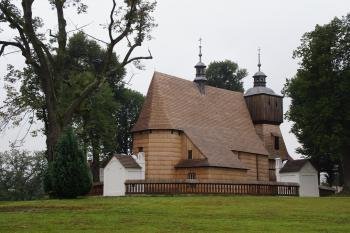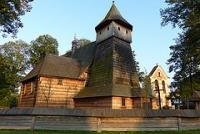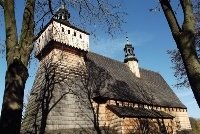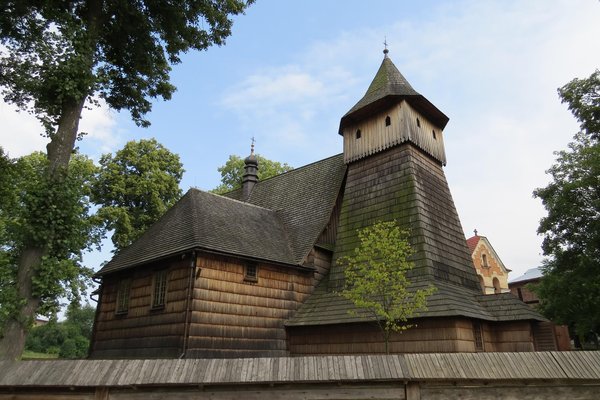Poland
Wooden Churches of Southern Malopolska
The Wooden Churches of Southern Malopolska comprise six medieval Gothic churches built in the horizontal log technique.
They belong to the Roman Catholic tradition and their layout arose from liturgical requirements. The construction of the churches was funded by wealthy sponsors as a sign of prestige. They lie in the Carpathian foothills, often in picturesque valleys, and are still in use.
Community Perspective: One of the "treasure hunt" experiences on the List. These churches lie in a very scenic region and deserve all to be visited (best by car). Be prepared to make phone calls to “the ladies with the key” (their numbers are posted near the churches’ doors) to open them up for you.
Site Info
Official Information
- Full Name
- Wooden Churches of Southern Malopolska (ID: 1053)
- Country
- Poland
- Status
-
Inscribed 2003
Site history
History of Wooden Churches of Southern Malopolska
- 2013: Name change
- From "Southern Little Poland" to "Southern Malopolska"
- 2003: Inscribed
- Inscribed
- 2002: Deferred
- To provide Management Plan
- Type
- Cultural
- Criteria
- iii
- iv
Links
- UNESCO
- whc.unesco.org
- Official
-
- haczow.pl — Haczow
- drewniana.malopolska.pl — Lipnica Murowana
- drewniana.malopolska.pl — Debno
- Related
-
- facebook.com — 3D version of Sekowa Church
- debno.diecezja.pl — Tourist information for Archangel Michael's Church at Debno Podhalanskie
- binarowa.wiara.org.pl — Binarowa
All Links
UNESCO.org
- whc.unesco.org — whc.unesco.org/
Official Website
- haczow.pl — Haczow
- drewniana.malopolska.pl — Lipnica Murowana
- drewniana.malopolska.pl — Debno
- drewniana.malopolska.pl — Binarowa
- drewniana.malopolska.pl — Sekowa
Forum Discussion
- worldheritagesite.org — Polish Wooden Churches
Related Resources
- facebook.com — 3D version of Sekowa Church
- debno.diecezja.pl — Tourist information for Archangel Michael's Church at Debno Podhalanskie
- binarowa.wiara.org.pl — Binarowa
Community Information
- Community Category
- Religious structure: Christian
Travel Information
Recent Connections
-
Damaged in World War I
The Saints Philip and James Church in S… -
Reduced from broader TWHS
TWHS comprised 9 wooden churches, the o… -
Name changes
From Southern Little Poland to Southern…
Connections of Wooden Churches of Southern Malopolska
- Geography
- Trivia
-
-
Built or owned by Germans
Hacz?w. In the 14th century there was a German settlement there called Hanshof.
-
- Architecture
- Damaged
-
-
Damaged in World War I
The Saints Philip and James Church in Sękowa was damaged during 1914–1915 years of World War I in the Gorlice–Tarnów Offensive. The wooden material was used for trenches and for firewood.See en.wikipedia.org
-
- World Heritage Process
-
-
Reduced from broader TWHS
TWHS comprised 9 wooden churches, the ones at Szalowa, Orawka and Lachowice were left out
-
- Timeline
-
-
Built in the 15th century
The oldest well preserved Roman Catholic wooden churches date back to the 15th century (AB ev)
-
- WHS Hotspots
- WHS Names
-
-
Name changes
From Southern Little Poland to Southern Malopolska (2013)
-
News
No news.
Recent Visitors
Visitors of Wooden Churches of Southern Malopolska
- Adrian Turtschi
- Afshin Iranpour
- Alexander Barabanov
- Alexander Lehmann
- Anna Wludarska
- Antonio J.
- Argo
- Artur Anuszewski
- Aspasia
- Atila Ege
- Bamse
- BaziFettehenne
- Bin
- Brendan Carroll
- Bropyk
- Carlos Sotelo
- Cezar Grozavu
- Cheryl
- Christoph
- Christravelblog
- Cirene Moraes
- Clyde
- Cody Ayers
- Colossus
- Csaba Nováczky
- ctravel
- czesioszpachelka
- Dagmara
- Dani Cyr
- Daniel Chazad
- Dan Pettigrew
- David Berlanda
- del
- Dimitar Krastev
- Dirk-pieter
- Dolemite92
- Dorejd
- Echwel
- Elaine McArdle
- Elia Vettorato
- Elisabeth Fransisca Situmorang
- Els Slots
- Erik Jelinek
- Errol Neo
- Eva Kisgyorgy
- Fan Yibo
- Felicité
- Femke Roos
- Filip Murlak
- FS
- Gary Arndt
- George Gdanski
- GeorgeIng61
- GerhardM
- Harry Mitsidis
- Hasco
- henrik_hannfors
- Highlander
- Hubert
- Hurrvinek
- Iain Jackson
- Ivan Rucek
- Jakob F.
- Janina Lehmann
- Jan-Willem
- Jarek Pokrzywnicki
- Jezza
- Joel on the Road
- Jonas Kremer
- Jonas Martinsson
- jonathanfr
- Jon Eshuijs
- Joyce van Soest
- KarenBMoore
- Kasia M.
- Kasper
- Kbecq
- KentishTownRocks
- Kurt Lauer
- Lara Adler
- LaVale
- Lisu Marian
- ljowers
- Loic Pedras
- Luboang
- Luis Filipe Gaspar
- Lukasz Palczewski
- lynnz317@aol.com
- Maciej Gil
- Maciej Gowin
- Malgorzata Kopczynska
- Małgosia Łupicka
- Martina Rúčková
- Marty
- Matejicek
- Mateusz
- MaxHeAnouBen
- MaYumin
- MH
- Michael Ayers
- Mikko
- Milan Jirasek
- Miloš Tašković
- MMM
- Mohboh
- nan
- Nick M
- Nihal Ege
- PabloNorte
- Patrik
- Paul Schofield
- Peter Lööv
- Petteri
- Philipp Leu
- Philipp Peterer
- Pincze
- Piotr Wasil
- Rafał Kałczuga
- Randi Thomsen
- Remigiusz
- rivr
- Roger Ourset
- Roman Bruehwiler
- Roman Raab
- Sandmann15
- serghei.belous
- Sergio Arjona
- Shandos Cleaver
- Slavi
- Solivagant
- Stanimir
- Stanislaw Warwas
- Stijn
- Svein Elias
- Szucs Tamas
- Tamara Ratz
- Taotao Chen
- Tarquinio_Superbo
- Tevity
- Thomas Buechler
- Thomas van der Walt
- Thorben
- Tim Allen
- Traveling Girl
- triath
- Tsunami
- usagi1974
- Valentina
- Vanessa Buechler
- Van Hung
- VB73
- voyager
- WalGra
- Walter
- Wojciech Fedoruk
- wrung24
- YaroMir
- Yevhen Ivanovych
- Zhenjun Liu
- Złoty Tłok Czesław
- Zoë Sheng
Community Reviews
Show full reviews
Southeastern Poland holds two sets of WH-listed wooden churches, which lie in overlapping areas. It’s an important travel decision whether to mix them and take in as many as possible while driving the most efficient route, or to separate them which also means not being able to visit every single one. I opted for the latter, as I thought otherwise the two sets would blur into one in my memory. I had about 1.5 days to spare in the area and devoted the first afternoon to two of The Wooden Churches of Southern Malopolska.
The most difficult thing about visiting any of the wooden churches is just finding them. I immediately ran into trouble with the first one, the church in Lipnica Murowana. Lipnica is a pretty cute and sizeable town, wherein the center I noticed a sign pointing to the "Church of St. Leonard” right away. However, when I entered the indicated street I ended up at a large modern church. I wondered how this could have the same name as the old wooden one!
I checked my notes for more clues and even burned some data on my smartphone to find location details or photos of the surroundings. One of the earlier reviewers wrote about “somewhere northeast of the center, with a large cemetery”. Driving around I found a small church within a big cemetery - but it did not look that old nor made out of wood. I was finally rescued by the waitress from …
Keep reading 0 comments
Three separate World Heritage sites in one region with a total of thirty individual sites - much ado just about wooden churches? At least these were my thoughts before we planned our trip to Lesser Poland and Slovakia in August 2014. But while reading the nomination documents and viewing the pictures to decide which of the sites might be worth a visit, I started to change my mind. And after we visited the first two or three, these lovely wooden churches had won me over. Finally, we visited eighteen of them, several more than we initially had planned.
All churches have in common a striking architecture and an enchanting interior with colourful paintings on the walls and ceilings. And they are located in beautiful rural settings, behind trees and surrounded by meadows. But this also means that most of them are in a rather remote area, thus I would endorse the recommendation by Clyde to use a navigation system and to previously check the coordinates in Google Maps or Google Earth.
Despite the obvious similarities between the three nominations there are distinct differences in architecture and interiors. The characteristic features of the churches included in the Southern Malopolska WHS: the nave and the chancel have a tall gable roof with a small bell-turret on top, on the west side is a tower with the main portal, and most of the churches are surrounded by (open) arcades called sobots. The tower is not or only marginally higher than the main roof.
…
Keep reading 0 comments
I visited this WHS in September 2014. I visited 5 out of the 9 wooden churches of Southern Malapolska and managed to enter 4 of them to see the frescoes and paintings. I combined this WHS with the Wooden Tserkvas of Poland and I dedicated a full day driving from one wooden church/tserkva to the next. In a way they reminded me of a similar "treasure hunt" experience I had when visiting the churches in Val de Boi, Spain. I really enjoyed myself but I managed to visit so many churches only because I had done my homework beforehand. First of all I searched the churches/tserkvas on Google Maps to get an idea of their location. This helped me to decide on a logical order to visit the churches. Next, I entered their exact location (longitude/latitude) on my GPS which turned out to be a very wise idea as most of the wooden churches are well hidden behind tall trees and signs were non-existant. I got this information from http://whc.unesco.org/archive/2002/noms/1053.pdf. Then I wrote down Poland's telephone code (0048) as I knew I would be needing it to be able to call the church keyholders once I got there. The first wooden church I visited was the one in Lachowice which is quite similar to the other 2 churches I visited in Lipnica Murowana and Sekowa. The former church was closed and the keyholder was nowhere to be seen or reached by mobile phone. I was luckier with the other 2 …
Keep reading 0 commentsjohn booth
Wooden Churches of Southern Malopolska
Wooden Churches of Southern Malopolska (Inscribed)

In October I visited three of the listed churches:
Debno : reached by bus from Krakow, changing at Nowy Targ. The driver stopped outside the church car park, and the church was open to visits.
Binarowa : reached by bus from Krosno, changing at Biecz. A service had just concluded and participants were spilling over the road when I arrived. I walked back to Biecz after my visit.
Haczow (pictured) : reached by bus from Krosno. The church was open to visits although no one was around.
Keep reading 0 comments
Very nice churches with walls nicely painted. In some cases, are not easily reached by car since some signs are missing on the roads and polish people drive dangerously. Here, I'm talking about the other drivers if you rent a car and also the driver of your coach if you consider a bus or mini-bus trip to these places.
Keep reading 0 comments
Wooden churches of southern Little Poland are immpressive places which are different from other major churches.
Living belief can be seen here and being wooden architectures reminded me of power of nature.
I've been to all six churches which was resistered,the Mass at debno made me immpressed at most.This photo is debno church at night.
Keep reading 0 commentsDavid Berlanda
Wooden Churches of Southern Malopolska
Wooden Churches of Southern Malopolska (Inscribed)

In our trip to Poland we have visited Lipnica Murowana and its wooden Gothic cemetery church of St. Leonard, constructed in 15th century outside the walls and reconstructed many times, in the horizontal log technique. It has a high roof with wooden shingles, an arcade around it and a nice portal. Inside there are wall paintings, polychrome decorations on the ceiling of the nave and of the chancel and a crypt with some tombs.
I was a little bit disappointed by the church because I imagined it bigger and more spectacular or decorated and also because it was closed, even if its architecture is of very good quality. I think however that it justifies the inscription because there aren't many wooden churches on the WHL and especially because they are a very important and widespread type of traditional buildings, but in my opinion the inscription can be largest, as to comprend all or some of the many other wooden churches of Poland, and also transboundary (there are many other wooden churches in Hungary, Slovakia, Romania and Ukraine). The church is very well conservated and it has a high degree of authentity. The title of the WHS "Wooden Churches of Southern Little Poland" seems to be uncorrect, because two of the churches are in the region of Subcarpathia; but the title is referred to the historical region of Little Poland. The church is worth to be seen if you are in the surroundings of Cracow but it's difficult to get there. …
Keep reading 0 commentsSolivagant
Wooden Churches of Southern Malopolska
Wooden Churches of Southern Malopolska (Inscribed)

The Southern border of Poland with Slovakia contains wonderful unspoilt scenery and justifies detailed exploration by car and on foot over as many days as you can spare during a holiday to Poland – or even a journey for its own sake. The geography of the area has meant that a special culture has been developed and at least partly maintained.
A major outward manifestation of this is the many wooden churches which dot the area. The road system is complicated as it follows valleys in and out of the Carpathian foothills – and the difficult-to-remember and pronounce (to non Poles!) region and village names make tracing a route even more complex.
There are many more churches than the 9 inscribed on the WHS list and to find and see all of them would require many hours of poring over a map and many hours of driving. Some of the best e.g. Binarowa and Sekowa (photo) are in the “Beskid Niski” region near Gorlice (Poland’s “Oil town”).The churches are set in meadows and shady forests. Most have steep roofs which reach near to the ground, creating an overhang under which peasants who had travelled many miles to arrive on the Saturday evening ready for early Sunday mass could sleep! The interiors range from the simple to the quite ornate. We found services going on in some of them. All in all it was a very pleasant part of a visit to Poland.
Although the WHS list is perhaps in danger …
Keep reading 0 comments
In late August 2000 I had the chance to visit family living in walking distance to St. Leonard Church in Lipnica Murowana.
The church was open and we had the chance to see the beautiful artwork within it's walls. Simplistic in nature, this church was quite a wonderful find tucked away in a lovely village.
Keep reading 0 comments
